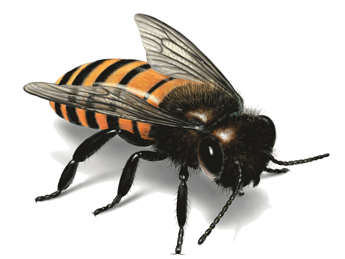
If a property owner suspects that a honey bee colony has entered the wall of a structure, he/she should attempt to confirm the insects are indeed honey bees. Honey bees vary in color from yellow to black, have black or brown bands across the abdomen and are much smaller than a carpenter bee. Honey bees are about 2/3 inch long and covered with hairs or setae. The foraging honey bees have pollen baskets on each hind leg, which will often be loaded with a ball of yellow or dark green pollen. The honey bee is the only stinging insect that can normally over winter as a colony inside the wall of a structure.
Honey bees may establish a nest inside the wall of the house or other building causing a problem, a health hazard and a serious danger to the structure.
Honey bee colonies in wall or attic voids are a much more serious problem than yellow jacket wasps. Yellow jacket colonies are annual and the wasps will disappear in the winter with or without treatment. Honey bee nests may last for many years without treatment and will contain honey stored inside the walls. The honey can ruin walls and ceilings if it is not removed.
Combs inside buildings should be removed to avoid problems with honey-stained walls and pest problems, such as carpet beetles, and attracting bee swarms in the future. Never use honey or wax from colonies that have been treated with an insecticide. Controlling honey bee nests can be challenging. Call us if you spot bees around or coming out of your home.
We are specialists when it comes to dealing with honey bees, yellow jackets, and their nests. Our Bee Control will leave no trace of bees in the present or future.
